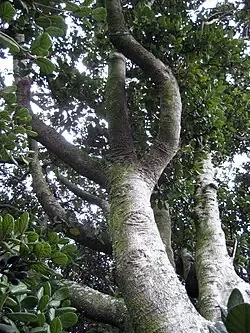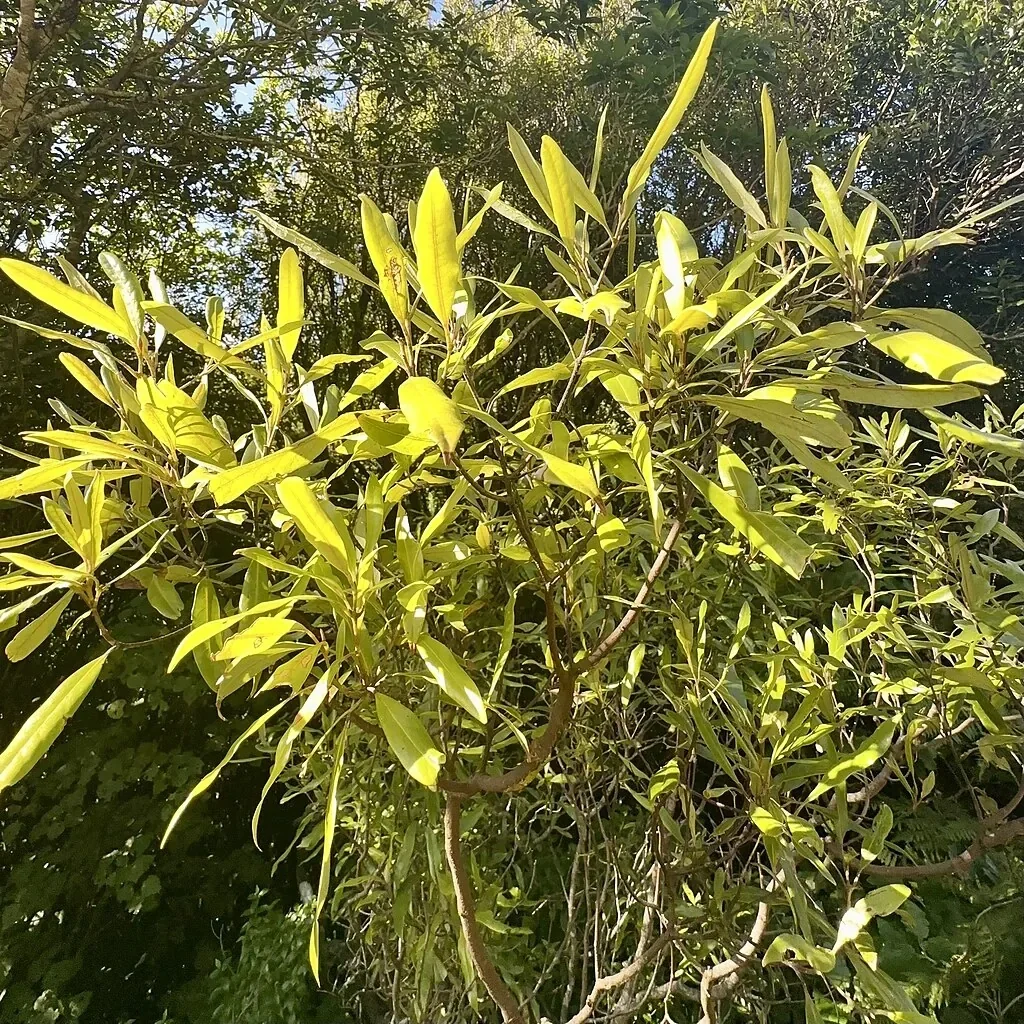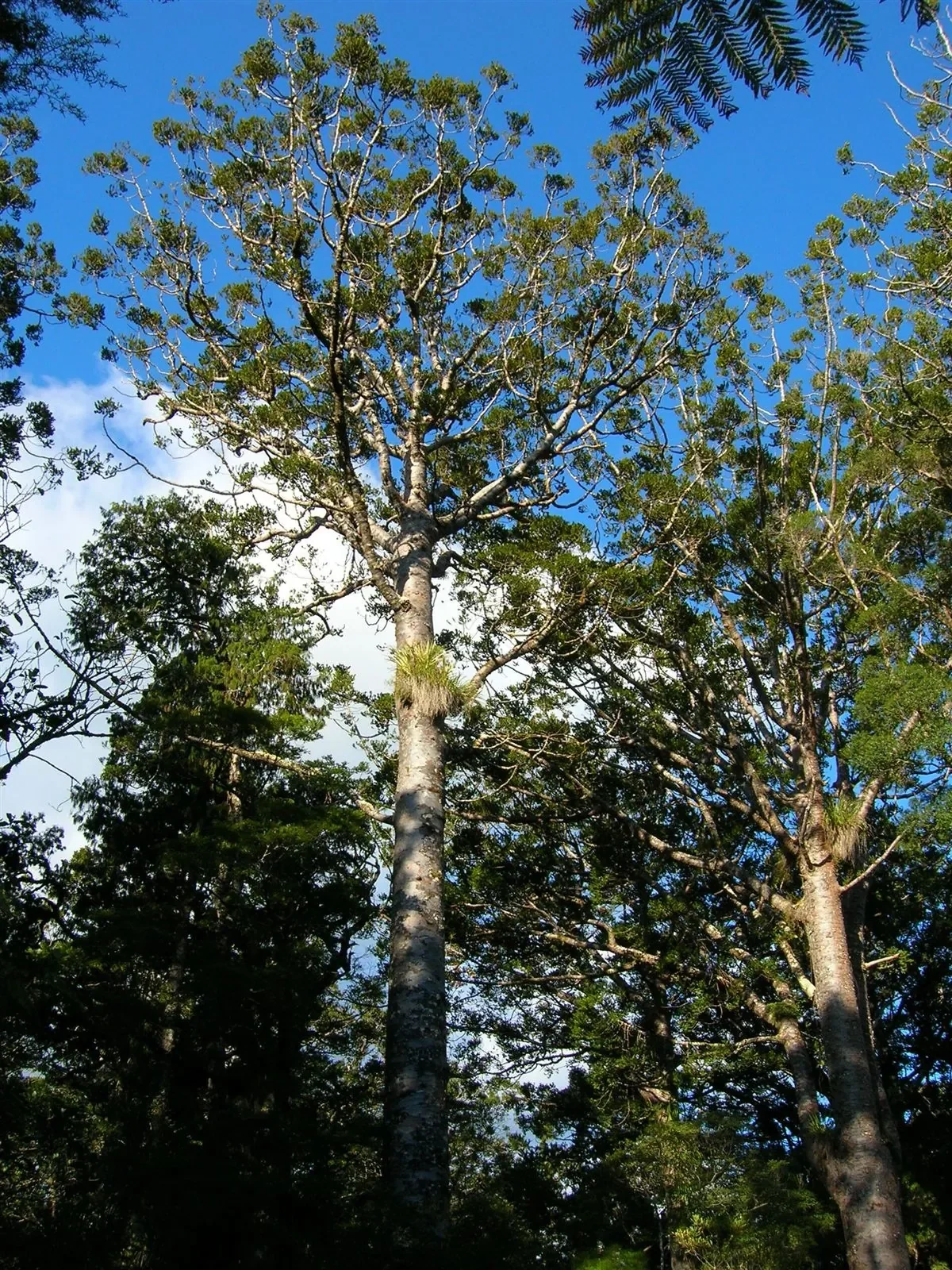
Taraire
Beilschmiedia tarairi
The Taraire ( Beilschmiedia tarairi ) is a magnificent evergreen tree endemic to the North Island of New Zealand. It is characterized by its broad crown, smooth dark brown bark, and distinctive dark-green, leathery leaves with depressed veins. The tree produces attractive plum-like fruits that turn dark purple when ripe, serving as a vital food source for the New Zealand pigeon (kererū). Growing alongside species like pūriri and tawāpou , it forms an integral part of northern lowland forest ecosystems.
The Taraire ( Beilschmiedia tarairi ) is a prominent evergreen tree of the New Zealand North Island's lowland forests. It can reach impressive heights of up to 22 meters with a broad, spreading crown and a trunk diameter of up to 1 meter. Its bark is smooth and dark brown, and young branchlets, leaves, and flower buds are covered in fine reddish-brown hairs.
The distinctive dark-green leaves are alternate, leathery, and simple, typically measuring between 50 and 72 mm long and 34 to 48 mm wide. A key identifying feature is their depressed veins, and they are often described as bullate (blistered or puckered) and glaucous (silvery) underneath.
From September to December, the Taraire produces erect panicles of small (3-5 mm) greenish flowers from its leaf axils, with flowering peaking in November. These are followed by the tree's most notable feature: its fruit. These are erect, elliptical to ovoid drupes, approximately 30 by 16 mm, which mature to a dark purple colour and are covered in a waxy bloom. Each plum-like fruit contains a single large seed and is a highly favored food source for the native New Zealand pigeon, the kererū ōī.

Plant Description
Physical Characteristics
The Taraire ( Beilschmiedia tarairi ) is a magnificent evergreen tree endemic to the North Island of New Zealand. It is characterized by its broad crown, smooth dark brown bark, and distinctive dark-green, leathery leaves with depressed veins. The tree produces attractive plum-like fruits that turn dark purple when ripe, serving as a vital food source for the New Zealand pigeon (kererū).
Quick Facts
Tree Summary
| Scientific Name | Beilschmiedia Tarairi |
|---|---|
| Height | Up to 22 m |
| Water Needs | Moderate; prefers moist, well-drained soil |
| Light | Partial shade to full sun |
| Spread | 8-15 m |
| Frost Tolerance | Moderate to high |
| Family | Lauraceae |
| Salt Tolerance | Low to moderate; prefers protection from strong salt exposure |
| Growth Rate | Slow to moderate |
| Lifespan | Very long; can live for centuries |
Climate Requirements
Taraire thrives in New Zealand's warm, humid subtropical climate and is naturally found only in the northern regions of the North Island. It requires a frost-free environment and performs best in areas with consistent rainfall and high humidity. The species is not tolerant of heavy frosts and struggles in dry, exposed conditions.
Ideal growing regions include Northland, Auckland, Bay of Plenty, and Coromandel Peninsula where the climate closely matches its natural habitat requirements. In cultivation, protect from cold winds and ensure adequate moisture during dry periods.
Taraire is a common canopy tree found in lowland forests primarily north of Auckland. It frequently grows in association with other iconic New Zealand trees such as kauri ( Agathis australis ), pōhutukawa ( Metrosideros excelsa ), Tāupou ( Planchonella costata ), and pūriri ( Vitex lucens ), particularly on basalt rocks and fertile soils.
Its natural distribution is confined to the North Island of New Zealand, generally north of 38°S latitude. It is most abundant in regions north of Auckland and Thames. Scattered populations can also be found on the west coast between Port Waikato and the Kawhia Harbour, inland at Pukemokemoke, and in various locations extending to East Cape on the east coast. The Taraire thrives in well-drained, fertile soils and prefers warm, frost-free environments, showing tolerance only to light frosts.
Regional Suitability
| City | Climate Suitability |
|---|---|
| Whangārei | Ideal |
| Auckland | Ideal |
| Hamilton | Ideal |
| Tauranga | Ideal |
| Rotorua | Ideal |
| Gisborne | Ideal |
| New Plymouth | Ideal |
| Napier | Ideal |
| Whanganui | Ideal |
| Palmerston North | Ideal |
| Wellington | Ideal |
| Nelson | Ideal |
| Christchurch | Ideal |
| Dunedin | Ideal |
| Invercargill | Ideal |
Natural Habitat
Typical Environments
Taraire naturally occurs in warm, humid lowland forests from North Cape to Raglan and East Cape, with highest abundance north of Auckland. It grows from sea level to 650 m elevation, preferring rich, well-draining soils in association with kauri, pōhutukawa, and pūriri.
Taraire is a common canopy tree found in lowland forests primarily north of Auckland. It frequently grows in association with other iconic New Zealand trees such as kauri ( Agathis australis ), pōhutukawa ( Metrosideros excelsa ), tāupou ( Planchonella costata ), and pūriri ( Vitex lucens ), particularly on basalt rocks and fertile soils.
Its natural distribution is confined to the North Island of New Zealand, generally north of 38°S latitude. It is most abundant in regions north of Auckland and Thames. Scattered populations can also be found on the west coast between Port Waikato and the Kawhia Harbour, inland at Pukemokemoke, and in various locations extending to East Cape on the east coast. The Taraire thrives in well-drained, fertile soils and prefers warm, frost-free environments, showing tolerance only to light frosts.
Plant Conservation
Threats and Efforts
Taraire ( Beilschmiedia tarairi ) is a native New Zealand tree with a national conservation status of "Not Threatened." This classification reflects its relatively stable populations within its natural range, which is restricted to the North Island, particularly in lowland and coastal forests from Te Paki south to the Waikato region.
Despite its secure national status, taraire faces ongoing conservation challenges that require continued attention and management. The primary threats include habitat fragmentation through land conversion for agriculture and urban development, which has reduced the continuous forest areas that taraire requires for optimal reproduction and genetic diversity. The species' limited dispersal mechanism, relying heavily on kererū ōī (New Zealand pigeon) for seed dispersal, makes it vulnerable to declines in native bird populations. Competition from invasive plant species and browsing pressure from introduced mammals also pose challenges to natural regeneration. Conservation efforts focus on protecting existing forest remnants, controlling invasive species, supporting kererū ōī populations through habitat restoration, and promoting taraire cultivation in appropriate restoration projects. Its ecological importance as a keystone species for native wildlife, particularly kererū ōī, makes its conservation crucial for maintaining broader forest ecosystem health. By supporting native forest protection, controlling invasive species, and promoting responsible cultivation practices, we can help ensure the continued survival of this culturally and ecologically significant native tree.
Growing Requirements
Soil
Well-draining, fertile soil rich in organic matter. Prefers deep, moist soils and cannot tolerate waterlogged conditions.
Light
Full sun to partial shade. Young plants benefit from some protection from intense afternoon sun.
Water
Regular watering during establishment. Once mature, is relatively drought tolerant but appreciates consistent moisture.
Planting Guide
Preparation Steps
Plant Taraire in spring after the last frost risk has passed. Dig a hole twice the width of the root ball and the same depth. Backfill with a mixture of native soil and compost. Water thoroughly after planting and mulch around the base, keeping mulch away from the trunk. Space trees at least 8-10 meters apart to allow for mature canopy spread.
Ecological Role
Ecosystem Roles
Taraire plays a crucial role as a canopy species in North Island lowland forests. It provides habitat for numerous native insects, birds, and other wildlife. The large fruits are particularly important for kererū ōī, which are the primary seed dispersers for this species. The tree also contributes to forest structure and biodiversity.
Uses
Traditional Uses
Historically, the Māori people occasionally consumed the flesh of the Taraire berries, and the seeds could be eaten after roasting or boiling.
The wood of the Taraire is straight-grained but is known for being brittle and prone to splitting, and it is not durable when exposed to the elements. Despite these limitations, it has been utilized for various purposes, including flooring, light carts, furniture, picture frames, ship's blocks, and as firewood. With modern treatment to enhance its durability, Taraire wood holds potential for high-quality, decorative applications.
Landscaping Uses
Design Ideas
Taraire makes an excellent specimen tree for large gardens and parks in suitable climates. Use as a canopy tree in native restoration projects or as part of mixed native plantings. Its broad canopy provides excellent shade, making it valuable for creating cool spaces in warm climates.
Seasonal Care
Spring
Apply mulch and organic fertilizer. Monitor new growth and water regularly during dry spells.
Summer
Ensure consistent watering. Harvest ripe fruits in late summer for propagation.
Autumn
Continue fruit harvest. Reduce watering as growth slows. Clear fallen leaves if desired.
Winter
Minimal care needed. Protect young trees from frost if necessary in marginal climates.
Pruning
Techniques and Timing
Taraire requires minimal pruning once established. Prune lightly in late winter or early spring to remove dead, damaged, or crossing branches. Shape young trees if needed to develop a strong structure, but avoid heavy pruning as this can stress the tree. Focus on maintaining good air circulation through the canopy.
How to Grow Taraire
Seeds
Seed propagation is the primary and most successful method for growing Taraire, taking advantage of the species' natural reproductive strategy and remarkable adaptation to New Zealand's forest ecosystems. This method closely mimics the natural process where kererū ōī (New Zealand pigeons) consume the large, nutritious fruits and disperse the seeds throughout the forest, creating new colonies in suitable growing locations. For cultivation purposes, collect ripe fruits during the extended fruiting season from March to November, selecting fruits that have turned dark purple-black and feel soft to the touch. The optimal collection strategy involves gathering freshly fallen fruits that are still viable, as these have reached full maturity and contain seeds with maximum viability. Each large fruit contains a single rough-textured stone surrounded by fleshy pulp that must be removed for optimal germination success. Allow collected fruits to soften naturally, then wash away all fleshy material under running water, leaving only the dense, cleaned seeds behind. This cleaning process is crucial as residual fruit material can inhibit germination and promote fungal growth that may damage developing seedlings. Press the prepared seeds into a firm, flat bed of quality seed-raising mix, covering only lightly with additional growing medium or fine pumice to provide gentle protection while allowing adequate light penetration. Taraire seeds require no pre-treatment and will germinate naturally without stratification or scarification, making them exceptionally easy to handle compared to many native species. Maintain consistently moist conditions throughout the germination period, which typically extends from late summer sowing through to spring emergence, requiring patience as germination may take several months to complete. Seedlings usually emerge the spring following late summer sowing, developing slowly into small trees with the characteristic dark green, leathery leaves that make this species so distinctive. This method is particularly valuable for restoration projects where natural genetic diversity is important, and for gardeners seeking to establish trees adapted to specific local growing conditions while supporting the ecological relationship between Taraire and native wildlife.
Cuttings
Cutting propagation offers an alternative method for Taraire propagation, though it requires more specialized techniques and provides less reliable results compared to seed propagation. This method is particularly valuable when working with superior specimens that have proven successful in specific growing conditions, or when genetic uniformity is desired for landscape plantings. The optimal timing for taking cuttings is during late summer or early autumn when new growth has begun to harden but still retains some flexibility, providing the best balance between maturity and rooting potential. Select healthy, vigorous shoots from the current season's growth, choosing material that shows no signs of disease, insect damage, or environmental stress. Cuttings should be 10-15 centimeters long and taken from semi-hardwood growth that bends without breaking when gently curved. Prepare cuttings by making a clean cut just below a leaf node using sharp, sterilized pruning shears, then remove lower leaves to prevent moisture loss while retaining 2-3 pairs of upper leaves for photosynthesis. Treatment with rooting hormone powder or gel significantly improves success rates, as Taraire can be slow to develop roots naturally. Insert prepared cuttings into a well-draining propagation mix consisting of equal parts peat moss, perlite, and coarse sand, ensuring the mixture provides adequate drainage while retaining sufficient moisture. Maintain high humidity around cuttings by covering with clear plastic or placing in a mist propagation system, while providing bright, indirect light without direct sun exposure that could stress the developing roots. Keep the growing medium consistently moist but not waterlogged, as excessive moisture can lead to fungal problems that may kill developing cuttings. Rooting typically takes 3-6 months under optimal conditions, requiring patience and consistent care throughout the establishment period. Monitor cuttings regularly for signs of new growth, which indicates successful root development, and gradually acclimatize rooted cuttings to normal growing conditions before transplanting to their permanent locations. While this method requires more specialized equipment and attention than seed propagation, it allows propagation of specific cultivars or superior forms that may not come true from seed.
Grafting
Grafting represents the most advanced propagation technique for Taraire, typically employed by professional nurseries and experienced propagators working with rare cultivars or when rapid multiplication of superior specimens is required. This method involves joining a piece of desired Taraire variety (scion) onto the rootstock of a compatible species, usually another Taraire or closely related Beilschmiedia species that provides vigor and adaptability. The optimal timing for grafting is during late winter or early spring when both rootstock and scion wood are dormant but beginning to show signs of renewed growth activity. Select healthy, vigorous rootstock plants that have been grown for at least one year and show strong root development and disease resistance. Choose scion wood from the current season's growth of the desired variety, ensuring material is healthy, pest-free, and has well-developed buds that will provide the framework for future growth. Common grafting techniques for Taraire include whip-and-tongue grafts for material of similar diameter, or cleft grafts when working with larger rootstock and smaller scion wood. Prepare both rootstock and scion with clean, sharp grafting knives, creating matching cuts that allow maximum cambium contact between the two pieces. Bind the graft union securely with grafting tape or rubber strips, ensuring firm contact while avoiding excessive pressure that could damage delicate tissues. Seal the graft union with grafting wax or compound to prevent moisture loss and protect against infection while the tissues heal and grow together. Maintain grafted plants in a protected environment with high humidity and moderate temperatures until the union has healed completely, typically requiring 6-8 weeks under optimal conditions. Monitor grafts carefully for signs of success, including new growth from the scion and callus formation at the graft union, while removing any growth from the rootstock that might compete with the grafted variety. This advanced technique requires considerable skill and specialized knowledge, but provides the advantage of combining superior variety characteristics with robust rootstock performance for challenging growing conditions.
Pests and Diseases
Common Issues
Taraire is generally pest-resistant due to its native adaptations. Occasionally affected by scale insects or caterpillars on young growth. Monitor regularly and treat with horticultural oil if necessary.
Disease Prevention
Ensure good drainage to prevent root rot. Avoid overwatering, especially in heavy soils. Maintain good air circulation around the tree and remove any diseased plant material promptly.
Cultural Significance
Traditional Uses and Values
The large, plum-like fruits of the Taraire were a food source for Māori, and the wood was used for various purposes, including construction and carving. The tree also features in traditional stories and is an important part of the cultural landscape of the North Island.
Bonus Tip
Expert Growing Advice
The Taraire tree is a key player in a fascinating ecological relationship with the rare native orchid, Danhatchia australis . This orchid grows in the leaf litter beneath Taraire trees and is what is known as a myco-heterotroph, meaning it gets its nutrients by parasitizing fungi in the soil, rather than through photosynthesis. These fungi, in turn, have a symbiotic relationship with the Taraire's roots. This intricate web of connections highlights the complex and often hidden relationships within New Zealand's native forests.







